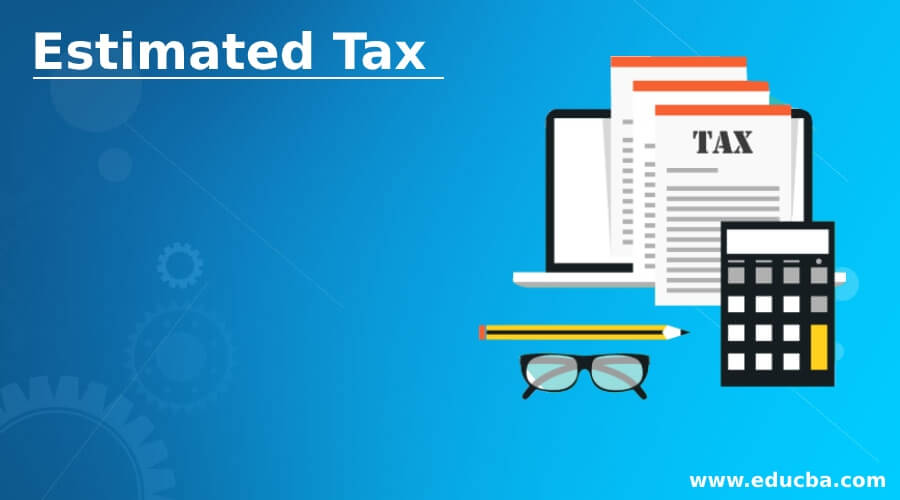Updated July 19, 2023
Definition of Estimated Tax
Estimated tax is a calculation based on which taxpayers pay taxes on their income, which is not subject to withholding taxes. Self-employed individuals usually calculate their estimated tax liability and pay it in four installments i.e. quarterly, as per the due dates. Employees whose taxes are not withheld by the employer also need to calculate their projected tax liability and pay it within the due dates.
Explanation
Estimated tax must be paid on all the income not subject to the withholding tax, like dividend income, taxable alimony, gains from the sale of stocks, cash prizes and awards, interest income, self-employment income, and so on.
As per IRS (Internal Revenue Service), individuals should make estimated tax payments if they expect the estimated tax calculation to be at least $1000 after deducting withholding tax and credits. However, no penalty would be levied on underpayment of estimated tax if taxpayers pay at least 90% of the tax for the present year or 100% as per the last year’s tax return, whichever is lower. Business filing as a corporation should pay estimated tax if the expected tax liability is $500 or more in the tax year.
The Formula for Estimated Tax
To calculate the estimated tax liability for a quarter below formula can be used:
As there are four quarters in a year, we have divided the total taxes for the year by four. This will give us the estimated tax liability for a quarter.
How to Calculate Estimated Tax?
Below are the steps detailing the calculation of the estimated tax for the tax year:
- Step 1: Calculating estimated taxable income of the year: First, every individual should calculate their gross adjusted taxable income after subtracting the estimated above-the-line and applicable standard deductions.
- Step 2: Calculation of income tax: In this step, the taxpayer should calculate the income tax by multiplying the adjusted gross income with the latest tax rate per the tax slab.
- Step 3: Calculating self-employment tax: This step requires the taxpayer to calculate their self-employment tax if their net earning is $400 or more. The total net earnings shall be multiplied by 92.35% since only the said percentage of the self-employment income is subject to self-employment tax. The resultant self-employment income would then be multiplied by the tax rate of 15.3% to get the figure of self-employment tax for the year.
- Step 4: Calculation of estimated tax liability for the quarter. In this final step, a taxpayer should add income and self-employment tax together and divide the resulting figure by 4 to get the tax liability for the quarter.
Example of Estimated Tax
Let us assume John’s adjusted gross taxable income relating to self-employment income is $80,000 after deducting above-the-line deduction and standard deduction; John is a single filer, and, therefore, the tax rate as per his current tax slabs is 22%. Now we need to calculate the estimated tax liability for the quarter.
Solution:
Estimated Taxable Income = $80,000
Income Tax calculates as
- Income Tax = $80,000 × 22%
- Income Tax = $17,600
Self-Employment Tax calculates as
- Self-Employment Tax = Self-Employment Income × 92.3% × 15.3%
- Self-Employment Tax = $80,000 × 92.3% × 15.3%
- Self-Employment Tax = $11,298
Estimated Tax Liability for a Quarter calculates as
- Estimated Tax Liability for a Quarter = (17,600 + 11,298)/4
- Estimated Tax Liability for a Quarter = $7,224.5
For the self-employment tax calculation, the total gross adjusted income is multiplied by 92.3% to get the self-employment taxable income figure multiplied by 15.3%. The self-employment tax rate combines the social security tax of 12.4% and Medicare of 2.9%.
Benefits of Estimated Tax
The benefits of the estimated tax are as follows:
- By paying the estimated tax quarterly, taxpayers can spread the burden of tax liability over the year.
- It is a mandatory requirement from IRS (Internal Revenue Service) to pay the estimated tax if the income is not subject to withholding tax, and not paying the estimated tax carries a penalty. Therefore, timely payment of estimated tax can help avoid late payment penalties.
- Payment of tax liability before the yearend also helps in planning and budgeting for the next year since, due to quarterly tax payments, last-minute hassles can now be avoided.
- It helps in maintaining paperwork in line with the requirement. Since the estimated tax is paid quarterly, taxpayers do not need to search for missing receipts or other deductible expenses at the yearend. They can remain on top of the paperwork by maintaining everything every quarter.
Disadvantages of Estimated Tax
The disadvantages of the estimated tax are as follows:
- Calculating and paying estimation tax every quarter is a very time-consuming process.
- Non-payment of estimated tax can attract penalties from the IRS, adding to the taxpayers’ burden.
- Underpayment of estimation tax also attracts a penalty from the IRS.
Conclusion
Every individual whose income is not subject to withholding tax needs to pay the estimated tax every quarter. Further, corporates are also required to pay estimated tax. The estimated tax can be calculated by adding income tax and self-employment tax together and dividing the resulting figure by four to get the tax liability for a quarter. One should be careful while paying the estimation tax because not paying an adequate amount results in a penalty by the IRS.
Recommended Articles
This is a guide to Estimated Tax. Here we also discuss the introduction and how to calculate estimated tax. Along with benefits and disadvantages. You may also have a look at the following articles to learn more –


